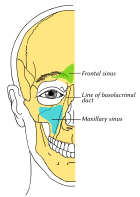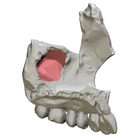Maxillary sinus
| Maxillary sinus | |
|---|---|
 Outline of bones of face, showing position of air sinuses. Maxillary sinus is shown in blue. | |
 Left maxilla, medial view. Maxillary sinus entry shown in red. | |
| Details | |
| Artery | infraorbital artery, posterior superior alveolar artery |
| Nerve | posterior superior alveolar nerve, middle superior alveolar nerve, anterior superior alveolar nerve, and infraorbital nerve |
| Identifiers | |
| Latin | sinus maxilliaris |
| MeSH | D008443 |
| TA98 | A02.1.12.023 |
| TA2 | 780 |
| FMA | 57715 |
| Anatomical terminology | |
The pyramid-shaped maxillary sinus (or antrum of
Structure
It is the largest air sinus in the body.
It has three recesses: an alveolar recess pointed inferiorly, bounded by the
Walls
The nasal wall of the maxillary sinus, or base, presents, in the disarticulated bone, a large, irregular aperture, communicating with the nasal cavity.[citation needed] In the articulated skull this aperture is much reduced in size by the following bones:
- the uncinate process of the ethmoid above,
- the ethmoidal process of the inferior nasal concha below,
- the vertical part of the palatine behind,
- and a small part of the lacrimal above and in front.
The sinus communicates through an opening into the semilunar hiatus on the lateral nasal wall.[citation needed]
The medial wall is composed primarily of cartilage.[1][3]
On the posterior wall are the alveolar canals, transmitting the posterior superior alveolar vessels and nerves to the molar teeth.[citation needed]
The floor is formed by the
The roof is formed by the floor of the orbit. It is traversed by infraorbital nerves and vessels.[citation needed]
Features
The infraorbital canal forms a ridge at the junction of the roof and anterior wall of the sinus;[5] additional ridges are sometimes seen in the posterior wall of the cavity and are caused by the alveolar canals.[citation needed]
Innervation
The mucous membranes receive their mucomotor
The superior alveolar (anterior, middle, and posterior) nerves, branches of the
Microanatomy
The sinus is lined with
Relations
The roof of the sinus is also the floor of the orbit. Posterior to the sinus and its wall are the pterygopalatine fossa and the infratemporal fossa.[5]
Variation
After puberty, the maxillary sinus rapidly increases in size. Its size is variable in the adult; if large, it may extend into the zygomatic process and alveolar process of the maxilla.[5]
Extension into the maxillary alveolar process may cause the roots of the molars and even premolars to lie just beneath the floor of the sinus or even project through the floor and into the sinus; in such cases, the roots of the teeth are typically surrounded by a thin layer of bone, but may sometimes lie directly underneath the mucous membrane of the sinus. Projection of the roots into the maxillary sinus is more common in advanced age due to
Development
Maxillary sinus is the first

Clinical significance
Maxillary sinusitis

Maxillary
Maxillary sinusitis is common due to the close anatomic relation of the frontal sinus, anterior ethmoidal sinus and the maxillary teeth, allowing for easy spread of infection. Differential diagnosis of dental problems needs to be done due to the close proximity to the teeth since the pain from sinusitis can seem to be dentally related.[1] Furthermore, the drainage orifice lies near the roof of the sinus, and so the maxillary sinus does not drain well, and infection develops more easily. The maxillary sinus may drain into the mouth via an abnormal opening, an oroantral fistula, a particular risk after tooth extraction.
Oro-antral communication (OAC)
An OAC is an abnormal physical communication between the maxillary sinus and the mouth. This opening is only present when the structures that normally separates the mouth and sinus into 2 separate compartments are lost.[9]
There are many causes of an OAC. The most common reason is following extraction of a posterior maxillary (upper) premolar or molar tooth. Other causes include trauma, pathology (e.g. tumours or cysts), infection or iatrogenic damage during surgery. Iatrogenic damage during dental treatment accounts for nearly half of the incidence of dental-related maxillary sinusitis.[10] There is always a thin layer of mucous membrane (Schneiderian membrane) and usually bone between the roots of the upper back teeth and the floor of the maxillary sinus. However, the bone can vary in thickness in different individuals, ranging from complete absence to 12mm thick.[10] Therefore, in certain individuals the membrane +/- the bony floor of the sinus can be perforated easily, creating an opening into the mouth when a tooth is extracted.[11]
An OAC that is smaller than 2mm can heal spontaneously i.e. closure of the opening.[12] Those that are larger than 2mm have a higher chance of developing into oro-antral fistula (OAF).[12] The passage is only defined as an OAF if it is persistent and lined by epithelium.[12] Epithelialisation happens when an OAC persist for at least 2–3 days and oral epithelial cells proliferate to line the defect. Large defects (more than 2mm) should be surgically closed as soon as possible to avoid accumulation of food and saliva which could contaminate the maxillary sinus, leading to infection (sinusitis).[12] Various surgical techniques can be employed to manage an OAF but the most common involves pulling and stitching some soft tissue from the gum to cover the opening (i.e. soft tissue flap).[12]
Sinusitis treatment
Traditionally the treatment of acute maxillary sinusitis is usually prescription of a broad-spectrum cephalosporin antibiotic resistant to beta-lactamase, administered for 10 days. Recent studies have found that the cause of chronic sinus infections lies in the nasal mucus, not in the nasal and sinus tissue targeted by standard treatment. This suggests a beneficial effect in treatments that target primarily the underlying and presumably damage-inflicting nasal and sinus membrane inflammation, instead of the secondary bacterial infection that has been the primary target of past treatments for the disease. Also, surgical procedures with chronic sinus infections are now changing with the direct removal of the mucus, which is loaded with toxins from the inflammatory cells[citation needed], rather than the inflamed tissue during surgery. Leaving the mucus behind might predispose early recurrence of the chronic sinus infection. If any surgery is performed, it is to enlarge the ostia in the lateral walls of the nasal cavity, creating adequate drainage.[8]
Cancer
-
Maxillary sinus cancer that has spread to the brain
-
Maxillary sinus cancer that has spread to the lymph nodes
Age
With age, the enlarging maxillary sinus may even begin to surround the roots of the maxillary posterior teeth and extend its margins into the body of the zygomatic bone. If the maxillary posterior teeth are lost, the maxillary sinus may expand even more, thinning the bony floor of the alveolar process so that only a thin shell of bone is present.[8]
History
The maxillary sinus was first discovered and illustrated by Leonardo da Vinci, but the earliest attribution of significance was given to Nathaniel Highmore, the British surgeon and anatomist who described it in detail in his 1651 treatise.[13]
See also
- Ohngren's line
- Zygomatic complex fracture
References
- ^ a b c d e f g Human Anatomy, Jacobs, Elsevier, 2008, page 209-210
- ^ OCLC 1044772257.)
{{cite book}}: CS1 maint: location missing publisher (link - ^ a b c d e Bell, G.W., et al. Maxillary sinus disease: diagnosis and treatment, British Dental Journal 210, 113 - 118 (2011) at http://www.nature.com/bdj/journal/v210/n3/full/sj.bdj.2011.47.html
- ^ Human Anatomy, Jacobs, Elsevier, 2008, page 209-210
- ^ ISBN 978-0-7295-3752-0.
- ^ S2CID 7915256.
- ISSN 0271-5333.
- ^ a b c Illustrated Anatomy of the Head and Neck, Fehrenbach and Herring, Elsevier, 2012, page 67
- PMID 30113083.
- ^ a b Regimantas Simuntis; Ričardas Kubilius; Saulius Vaitkus (2014). "Odontogenic maxillary sinusitis: A review" (PDF). Stomatologija, Baltic Dental and Maxillofacial Journal.
- PMID 20711106.
- ^ PMID 28289607.
- ^ Merriam-Webster's Medical Desk Dictionary Revised Ed. 2002, pg 49.
External links
- Radiology image: Headneck:17Maxill from Radiology Atlas at SUNY Downstate Medical Center (need to enable Java)
- Cross section image: skull/x-front—Plastination Laboratory at the Medical University of Vienna
- lesson9 at The Anatomy Lesson by Wesley Norman (Georgetown University) (latnasalwall3, nasalcavitfrontsec)
- Maxillary Sinus: Normal Anatomy & Variants at http://uwmsk.org/sinusanatomy2/Maxillary-Normal.html
- Cancer in the maxillary sinus, Stanford University at http://cancer.stanford.edu/headneck/sinus/sinus_max.html


